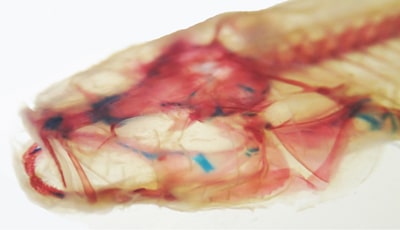
Indiana's New Resident: The Hoosier Cavefish
Matthew Niemiller is a man of science. He has a Ph.D in ecology and evolutionary biology and earns a living studying fish. Niemiller is also a man of contradictions. A native Hoosier and a proud fan of Bloomington hoops, he is employed by the University of Kentucky—Indiana University’s biggest rival—and works in its Department of Biology as a post-doctoral researcher.
Though the Wildcats pay the bills, Niemiller will always bleed cream and crimson. So fanatical is he when it comes to Hoosier basketball, he recently named a new species of cavefish in honor of that team and IU’s historic relationship to the study of ichthyology.
Meet the Hoosier Cavefish, scientific name Amblyopsis hoosieri. It’s blind, seldom grows over three inches in length, dwells in the caves of Southern Indiana, and is the victim of unfortunate anatomy—its anus is precariously close to its head.
Curious as to why this newest Indiana resident was assembled in such odd fashion, we talked to Niemiller about the discovery, the attention it has garnered, and what other names he would have bestowed upon the creature:
First things first, the Hoosier Cavefish has received a lot of attention in the blogosphere for the unseemly placement of its anus behind its head. When you made that discovery, did you think it would receive so much press?
Honestly, no. And the reason being is, if you think about all living vertebrae animals—including mammals and [humans]—we all have our anus behind our head. If we didn’t it would be a problem. There are actually a lot of fish that have this condition, and [the anus] is kind of migrated toward the throat. It seems like it’s on the head, but it’s really not. So, from my biological background, I didn’t think about that at all. But I actually thought it was pretty damned hilarious.
As there are a lot of fish with this condition, it sounds like this isn’t just nature’s cruel twist of fate. What’s the biological function of having your butt so close to your face?
Well, it’s not entirely clear. But, for this particular species, there are a few examples where it’s known that they’ll actually take care of their eggs within their gill chamber, so basically within their mouths. These are blind fish that live in a pretty hostile environment, so this might just be an adaptation to make sure their young [survive].
What other interesting facts about the fish are being overlooked?
A couple of the blog posts said [the fish] looked like a dick, which I also thought was pretty damned hilarious because if your dick looks like that, then you’ve got some major problems. My brother is a stand-up comedian based in Indy, so he thinks it’s great. He’s said he’s going to start working it into his routine at some point.
But it’s an interesting fish. It’s already endangered in Indiana. There are only a few populations that are actually large, and a lot of them are around the Mitchell area, where my mom’s family’s from. So it was kind of fun being able to name it after Indiana University, for several reasons.
As the fish is endangered, what needs to be done in order to protect and save the species?
The biggest threat to this species, and actually to a lot of cave-oriented fish, is groundwater pollution. A lot of streams that cavefish are living in are in rural areas, and that water is used for well water, so keeping water clean not only for the fish but for people is important. Things like agricultural runoff, pesticides, herbicides—all these things can get into the water system.
The main reason they’re endangered is because there are not that many large populations that are known, so hopefully with more research in the coming years we can find additional populations.

Growing up, I was always outdoors. I was always fishing, I was always hunting. I loved catching bugs, stuff like that. It took until my college career—at Rose-Hulman of all places—to realize that studying computer engineering wasn’t going to make me happy. So I transferred to Indiana State and got into biology. … But I’d been to a couple of the caves in and around Bedford and around Mitchell as a kid. My mom would take me on hikes, but I was really afraid of the dark, so we’d go just inside the cave; we wouldn’t go any farther. So that’s a weird path to start studying cave life.
Switching to hoops, what are your thoughts on IU’s recent struggles?
Well, [they] need some big men, that’s for sure. They need to get more productivity out of [sophomore forward] Hanner Perea this year. Hopefully some of the freshmen coming in this year, like [Jeremiah] April, can step in and get minutes. I think they’ll be fine after this year. Last year, they didn’t have any outside shooting aside from [junior point guard] Yogi Ferrell. They’d give the ball to [former Hoosier] Noah [Vonleh] in the post, and he’d get double- or triple-teamed because there was no one else to kick it back to and hit an open shot. I’m hoping they can make the tournament—Tom Crean is on the hot seat—and hopefully they can turn it around.
As an IU fan who works at Kentucky, how does that go over with your colleagues?
It’s pretty difficult being a Hoosier fan in Lexington. I wear my Hoosier red all the time, and I think it makes me a lot of enemies on campus, but I’m not scared.
When you have children, what will you teach them first, basketball or biology?
Oh, basketball. They’ll have an appreciation for the outdoors, but they will be IU basketball fans.





